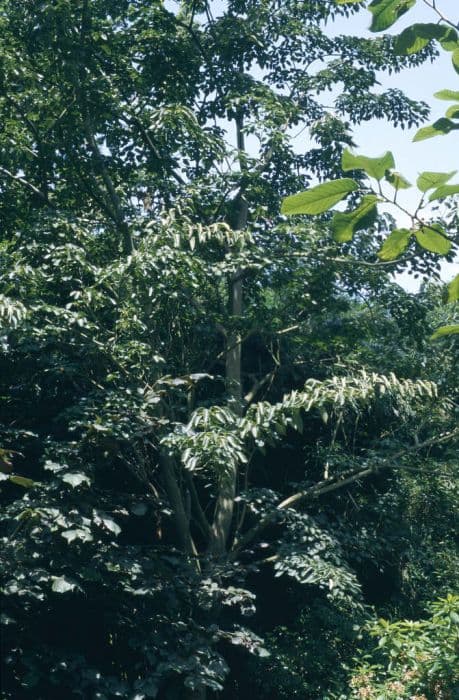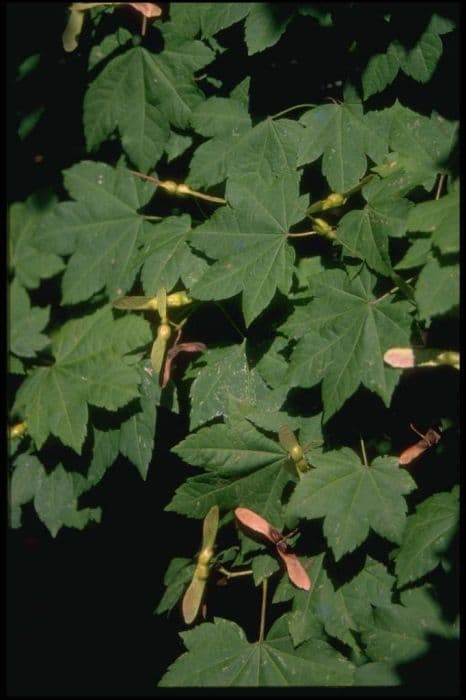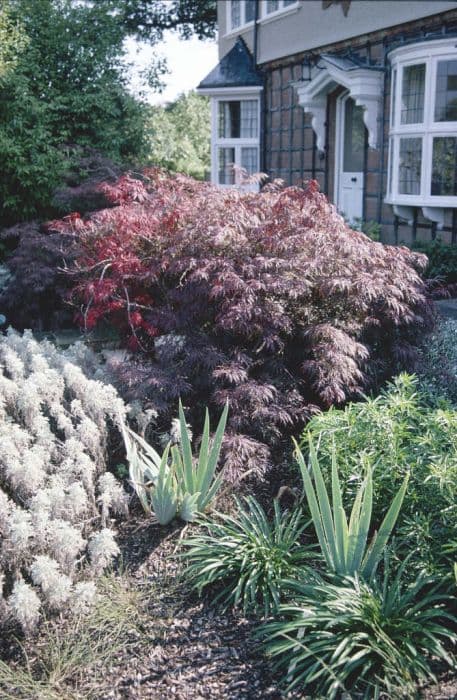Lobel's Maple Acer cappadocicum subsp. lobelii

ABOUT
This plant, commonly known as the Cappadocian maple, is recognized for its attractive foliage and overall elegant appearance. It bears distinct leaves that are palmately lobed, typically featuring five pointed lobes that can resemble a hand in shape. The leaves display a lush green color throughout the growing season, and they are known to undergo a striking transformation in autumn. As the seasons change, the foliage takes on a spectacular range of colors, from golden yellow to a rich orange or even a warm red, creating a vibrant canopy that stands out in the landscape. The transition of the leaves' colors is one of the highlights of this tree's appearance. The Cappadocian maple blooms in the spring, producing modest flowers that are often green or yellowish. These flowers might not be the most conspicuous feature but do contribute to the tree's spring appeal. Following the flowering season, the tree produces fruit that is characterized by winged seeds, which are typically arranged in pairs. The seeds, commonly known as 'samaras,' are designed to spin through the air as they fall, aiding in seed dispersal. The bark of the tree is another notable feature, providing texture and visual interest. It may vary in color, but often has a smooth surface that becomes slightly furrowed with age. Overall, the Cappadocian maple possesses an attractive, rounded canopy with a pleasant, harmonious form. It is often chosen for its ornamental qualities and its ability to provide a captivating display of color through the seasons.
About this plant
 Names
NamesFamily
Sapindaceae
Synonyms
Cappadocian Maple, Coliseum Maple
Common names
Acer lobelii Ten., Acer platanoides var. lobelii (Ten.) Fiori, Acer cappadocicum var. lobelii (Ten.) Pax.
 Toxicity
ToxicityTo humans
The Acer cappadocicum subsp. lobelii, commonly known as Cappadocian maple, is not typically known for being toxic to humans. There is no widespread evidence of toxicity or poisonous effects from ingesting parts of this tree in the general human population. Nonetheless, it is usually advisable to avoid eating parts of ornamental plants due to potential individual allergies or gastrointestinal upset.
To pets
The Cappadocian maple is not known to be toxic to pets such as dogs and cats. There is no well-documented evidence of poisoning or harmful effects from this plant in pets. However, as with any non-food plant, ingestion can potentially cause mild stomach upset in some animals, although serious toxicity is unlikely. Owners should still prevent pets from consuming plants that are not meant to be part of their diet to avoid any possible adverse reactions.
 Characteristics
CharacteristicsLife cycle
Perennials
Foliage type
Deciduous
Color of leaves
Green
Flower color
Yellow
Height
20-30 ft (6-9 m)
Spread
20-30 ft (6-9 m)
Plant type
Tree
Hardiness zones
5
Native area
Southeastern Europe
Benefits
 General Benefits
General Benefits- Aesthetic Appeal: The Cappadocian maple is appreciated for its ornamental value with its attractive foliage that changes through the seasons.
- Shade Provider: As a medium to large-sized tree, it can offer considerable shade in gardens and parks.
- Ecosystem Support: Being a native tree, it supports local wildlife, providing habitat and food for various birds and insects.
- Soil Improvement: Like many trees, it can help improve soil structure and nutrient content through leaf litter and root growth.
- Seasonal Interest: It has distinctive seasonal changes, offering a range of colors from green to golden yellow, providing visual interest throughout the year.
- Carbon Sequestration: By growing this tree, it contributes to carbon sequestration, thus having a positive impact on the environment.
 Medical Properties
Medical PropertiesThis plant is not used for medical purposes.
 Air-purifying Qualities
Air-purifying QualitiesThis plant is not specifically known for air purifying qualities.
 Other Uses
Other Uses- The wood of Acer cappadocicum, commonly known as Cappadocian maple, can be used for woodworking and crafting fine furniture due to its workable properties and attractive grain.
- It's suitable for making musical instruments such as guitars or violins because of its tonal quality and resonance.
- Leaves from the Cappadocian maple can be composted to create a rich organic matter that benefits garden soil.
- The tree can be tapped for sap, which can be reduced through a boiling process to make a syrup similar to that produced by the sugar maple.
- The brightly colored autumn leaves can be collected and used in decorative crafts or as a natural dye for fabrics.
- Larger branches and trunks can be used in carpentry to create unique and artistic natural-edge slabs for tables or countertops.
- In landscaping, the Cappadocian maple serves not only as an ornamental tree but also as a shade provider in gardens and parks.
- The seeds, known as samaras, can be utilized in educational settings for teaching about wind dispersal and plant reproductive strategies.
- The Cappadocian maple can be used as a natural windbreak or to provide privacy screening in suburban or rural settings.
- The tree's aesthetic value makes it a candidate for bonsai, requiring expert pruning and care to create miniature living art forms.
Interesting Facts
 Feng Shui
Feng ShuiThe Cappadocian maple is not used in Feng Shui practice.
 Zodiac Sign Compitability
Zodiac Sign CompitabilityThe Cappadocian maple is not used in astrology practice.
 Plant Symbolism
Plant Symbolism- Strength: Acer trees, commonly known as maple trees, are often associated with strength due to their hardy nature and robust wood.
- Endurance: Maple trees are known for their ability to withstand diverse climates, symbolizing endurance and perseverance.
- Beauty: With their diverse and beautiful foliage, maples are a symbol of beauty and aesthetic pleasure.
 Water
WaterCappadocian maple should be watered deeply and thoroughly, making sure the water penetrates the soil to reach the roots. The frequency of watering should be once a week during dry periods, although this may vary based on climate conditions and soil type. Aim to provide about 1 to 1.5 gallons of water each time, ensuring that the soil is moist but not waterlogged. During the growing season, keep the soil consistently moist, and reduce watering in the dormant winter months.
 Light
LightCappadocian maple prefers full sun to partial shade. It thrives best in a location where it can receive at least four to six hours of direct sunlight daily but is also protected from the harshest midday sun. A spot that offers morning light and afternoon shade is ideal for this tree to grow healthy and produce vibrant foliage.
 Temperature
TemperatureCappadocian maple can tolerate a range of temperatures and is hardy in USDA zones 5 through 8. They can survive winter temperatures down to -20°F and are comfortable in the summer heat up to 80°F, but they prefer a moderate climate. The ideal temperature for these trees is between 50°F and 70°F.
 Pruning
PruningCappadocian maple benefits from pruning to maintain its shape, remove any dead or diseased branches, and encourage healthy growth. Prune during the dormant season in late winter or early spring before new leaves emerge. It’s typically not necessary to prune every year; a cycle of every 2 to 3 years is adequate. Remove only the necessary branches to maintain the structural integrity of the tree.
 Cleaning
CleaningAs needed
 Soil
SoilThe Cappadocian Maple requires a soil mix that provides good drainage, with fertile loam being ideal. Incorporate organic matter such as compost or well-rotted manure to nourish the soil. A slightly acidic to neutral pH, ranging from 6.0 to 7.5, will facilitate healthy growth.
 Repotting
RepottingCappadocian Maples do not need frequent repotting and can often be repotted every 3-5 years. Check the root system in the spring, and if the roots are circling the container, it's time to repot.
 Humidity & Misting
Humidity & MistingCappadocian Maples prefer moderate humidity levels outdoors but are generally adaptable to the ambient humidity found in most temperate climates.
 Suitable locations
Suitable locationsIndoor
Provide bright, indirect light and room to grow.
Outdoor
Full sun to partial shade, protect from strong winds.
Hardiness zone
5-7 USDA
 Life cycle
Life cycleAcer cappadocicum subsp. lobelii, commonly known as Lobel's maple, begins its life cycle with seed germination, which is dependent on suitable soil conditions and temperature, typically occurring in spring. Following germination, the seedling grows into a juvenile plant, developing a root system and a stem with leaves, entering a phase of rapid vegetative growth. As the plant matures, it forms a woody trunk and branches, entering the adult phase where it can reproduce; this involves flowering in spring, followed by pollination, often facilitated by wind or insects. After successful pollination, the flowers develop into winged samaras, which disperse from the parent plant by wind in autumn. The samaras, containing the seeds, land in a suitable location and overwinter, lying dormant until the next suitable germination period arrives. The Lobel's maple has a perennial life cycle, with mature trees living for several decades, completing this cycle many times over their lifespan.
 Propogation
PropogationPropogation time
Spring to summer
Propogation: Acer cappadocicum subsp. lobelii, commonly known as Cappadocian Maple, can typically be propagated by seed. The most popular method is to collect the winged seeds, known as samaras, in the fall as they mature. They require a period of cold stratification to break dormancy. This can be done by mixing the seeds with moist sand and refrigerating them at approximately 34 to 40 degrees Fahrenheit (1 to 4 degrees Celsius) for about 90 to 120 days. After stratification, the seeds can be sown in pots or a prepared nursery bed in spring. They should be planted shallowly, just covered with soil, and kept consistently moist until germination, which may take several weeks. As they grow, the strongest seedlings can be selected for further cultivation and eventual planting out.









